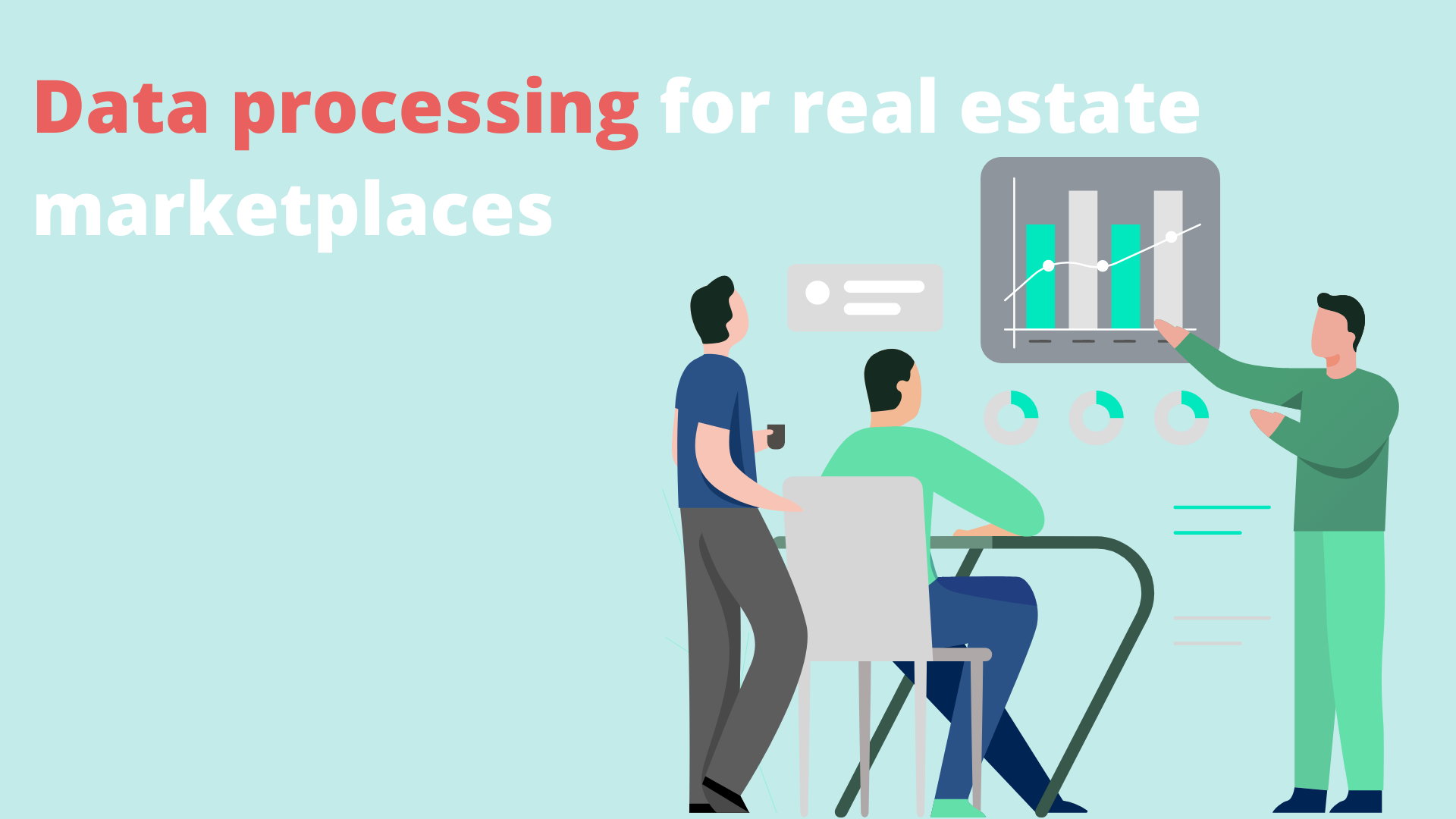Data Processing for Real Estate Marketplaces
18 June 2020 | 2 min read

Real estate marketplaces collect and host truly gargantuan amounts of data from a variety of sources. The real estate companies who input their data onto these platforms will often try to provide as much information as possible to promote fully actualized and relevant property rankings. When this data is processed well, real estate marketplaces become highly functioning hubs of user activity. However, when data processing is done poorly, real estate marketplaces can fail to meet user expectations.
Understanding Data Processing In Real Estate
Data processing is the operation performed on data to derive new information according to a pre-defined set of rules. This can include several processes, including data aggregation, validation, analysis, reporting, and more. The goal of data processing is to convert data into a desirable and usable form. There are four main stages in the data processing cycle:
1. Data collection
Data gathering or fact-finding. Data is extracted from available sources, including data lakes, databases, and specifically generated sources (surveys and questionnaires). For example, the marketplace could collect data from a residential and commercial property database. This database might include information like site details (geological and legal), purchase details, property tax information, and more.
2. Data preparation and input
This is a pre-processing stage where the raw data is “cleaned up”. The data is checked for errors, and incomplete, redundant, or incorrect data is removed or improved. Next, the data is input into the desired destination, where it can be stored, read, and retrieved by other software.
3. Data processing
This is where the real estate data is processed via machine learning algorithms for interpretation. Patterns can be found in the data, and these patterns can inform relevant search results.
4. Output
The data output should now be readable by non-data scientists, in this case, the end-users of the real estate marketplace.

Taking Control of Data Processing
Data processing involves a lot more than simply collecting data and knowing where to store it for retrieval. How accurate and reliable the data is can also have a considerable impact on the usability of the data. The challenge for real estate marketplaces is that they have limited control over the data that comes in. Sure, a real estate platform can create logic for forms, tables, and upload systems to try to combat this, but the system isn’t perfect. For example, consider the following situation:
A realtor wants to upload the details of a new property that has just gone onto the market. This property functionally has 4 bedrooms. However, only 3 of the bedrooms can be considered legal bedrooms. Some areas have restrictions on what can constitute a bedroom, and bedrooms have to meet specific requirements to be considered a bedroom legally. These requirements can include proper access (a staircase rather than a ladder), ceiling height, windows, and a minimum size requirement, i.e., 70 sq/ft.
When inputting the data, the realtor can only select the number of bedrooms without adding further clarity. The property in question has one bedroom that just falls short of the legal classification because it’s only 68 sq ft. However, it meets all the other requirements, and the people selling the property use that room as a bedroom. Still, the realtor is forced to either select 3 bedrooms or 4 bedrooms. Selecting “4 bedrooms) wouldn’t be correct because this property can’t be valued at the same price as a comparable 4 bedroom house. However, if they select “3 bedrooms”, they might fail to attract the attention of buyers whose desire is to buy a 4 bedroom house for the price of a 3 bedroom house.
This example is only one example of how designing data input forms can be endlessly complex, but many others exist.
So what’s the solution to this problem? There are two primary solutions. This first is to create increasingly detailed data input forms. The second is to utilize AI and machine learning to extract this information and use it to support advanced personalization. With AI and ML, algorithms can use the rules around bedroom size (or other property features) and information gathered around user preferences to deliver the most accurate and relevant results.
AI is also excellent at cleaning up the data before users on the site access it. If the search results contain inaccurate or redundant data, users may become frustrated for several reasons. They might see too many properties that don’t accurately match their wants and needs. They might also find properties that they like but later realize the information presented on the website wasn’t accurate. These experiences harm the reputation of the real estate marketplace and lead to higher bounce rates and fewer returning customers.

The Data-Driven Real Estate of the Future
Artificial intelligence and machine learning are advancing rapidly, and internet 4.0 is now becoming a reality. In the 2020s, we can expect to see increased integration of AI and ML solutions on real estate websites in many forms. For example, computer vision and image detection for extracting critical details about the condition and features of the property (fitted kitchens, recently renovated, a fireplace, etc.).
While real estate is often not considered a very technologically advanced industry, it has all the ingredients to be one. Real estate companies gather a vast amount of diverse data, including public records, photos, floor/site plans, geological data, historical purchasing data, and so on. That’s an awful lot of data and an awful lot of actionable insights to be gained.
Summary
Data processing is a critical activity for any real estate marketplace. Real estate marketplaces function at their best when data is processed accurately and cleanly. Users gravitate towards these websites because they are a hub for relevant property information and allow for a more comprehensive search. In the digital age, users don’t want to visit individual real estate websites when they are in the discovery and exploration stages of the customer journey. Instead, they want to browse properties on a marketplace using a variety of factors and variables to find the results that best match their needs. If real estate marketplaces wish to continue to serve these users, taking control of data processing is paramount.
If you’re ready to dabble in this technology and start providing better customer experiences, increase your conversions, and get ahead of your competitors, then we’re here to help. Reach out to us to get a free 30 min call with one of our experts and learn more about the possibilities of real estate technology. .
Related articles
How House Alerts Help To Obtain Higher Click-Through Rates
Thanks to house alert systems, you can quickly inform potential buyers when new properties that match their criteria show up. Here is a step-by-step guide that will show you how you can retarget potential customers and help them find the house of their dreams.
Two Unique Dashboards That Will Help Your Real Estate Agents Close More Deals
Being successful in sales is about knowing your product inside out and knowing everything there is to know about your customer. Luckily, it’s easier to achieve these two goals today than ever before by using some unique dashboards. Read everything about it here:
How Artificial Intelligence is Shaping the Online Real Estate Market
Now in 2021, the message is clear; AI is here, and it’s here to stay. But what impact does this technology have on the real estate market? Read everything about it in this article



